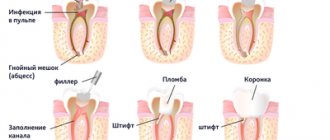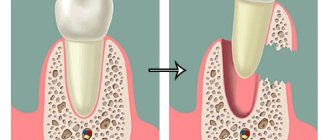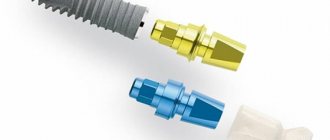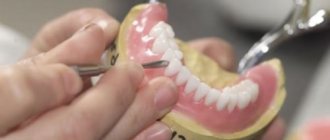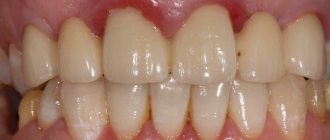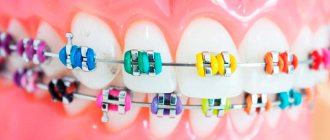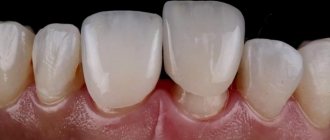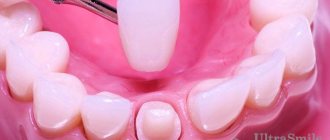Securing crowns with cement: technology features, pros and cons
The traditional method used by dentists at the start of prosthetics with implants and which has not lost its relevance to this day is as follows.
After comprehensive preparation of the oral cavity in general and the area for dental implantation in particular, the patient is implanted with an implant simulating the root of a tooth, onto which an add-on is installed - an abutment. And already on the abutment, using the same technology as on your own tooth, a crown is installed, fixed with cement.
Among the advantages of this method, it should be noted, first of all, affordability, ease of implementation and preservation of the integrity of the crown. The disadvantages of fixing a crown to an implant using dental cement are:
- entry of excess solution formed during fixation due to extrusion into the space between the gum and abutment. It is impossible to notice this process from the outside, so neither the patient nor the dentist can be sure that the cement has not entered the gum. In this case, there is a risk of inflammation of the bone tissue adjacent to the implant - peri-implantitis. Treatment of such a disease is long, complex and not always successful. A negative prognosis is the loss of the implant and part of the bone tissue, after which it will require its augmentation, and then re-implantation;
- If at least minimal inaccuracies were made when taking an impression and making the crown, its fit to the abutment will not be tight, which means that the dental cement filling this gap will be washed away by saliva over time. Its place will be taken by soft plaque containing pathogenic bacteria. As a result of decementation, the crown will simply fall out, and due to the action of bacteria, the previously mentioned peri-implantitis may begin to develop, followed by loss of the implant and bone mass.
Types of dental crowns for implants
The most common are ceramic or metal-ceramic crowns on implants. Other materials are not used in the manufacture of crowns due to the fact that certain difficulties arise during their operation. Thus, plastic crowns are not hygienic (they absorb odors well, bacteria take root well in them, and they are also susceptible to coloring with food coloring), metal ones are less aesthetically pleasing, and at the same time cause galvanic reactions in the mouth.
A ceramic dental crown for an implant consists of pressed ceramics or zirconium oxide and does not contain metal components. This type of crown has many advantages:
- Excellent aesthetic properties, allowing it to be used even on the front row of teeth;
- Hypoallergenic and lack of toxic components, which is why they do not cause negative effects on the mucous membrane and allergic reactions;
- High strength of the material;
- Natural color of the structure;
- No discomfort during operation;
- Prevents plaque formation.
A ceramic crown on an implant is the most flawless option for restoring teeth.
You can find out more about the prices and types of services provided related to implantology on this page. Everyone knows that you should always take care of your dental health. It is better to prevent a disease than to treat it later. Hygiene and prevention for you - /gigiena-profilaktika
The frame of a metal-ceramic crown is made of an alloy of cobalt and chromium, or nickel and chromium. In some cases, precious metals are used for this - palladium, platinum or gold. Such implant crowns have the following advantages:
- Excellent aesthetic indicators;
- High strength, which allows you to withstand large mechanical loads;
- Stability of the structure and resistance to displacement;
- Affordable price;
- Ease of manufacture;
- Easy to care for;
- Comfortable to wear;
- Long service life.
However, such crowns also have a number of disadvantages:
- Lack of light refraction in the smile area;
- The metal abutment reveals the artificiality of the tooth.
Fixing crowns using a screw method: are there any disadvantages?
The peculiarity of this method is that the abutment is not used as part of the structure, and the crown is screwed to the implant directly, using a screw. In this case, the prosthetist pre-fabricates a special crown with a hole for the screw. It would seem fast and reliable, why not? However, this fairly advanced technology is not without its drawbacks, in particular:
- aesthetic. It will not be possible to preserve the integrity of the crown covering the tooth: the shaft through which the fastening element passes will have to be closed with a composite filling. On the front teeth it will most likely be visible, so the patient will have to give up the dream of a perfect smile;
- functional. Due to the nuances of installation, the hole may occur in an area that is constantly under load, for example, on the cutting edge or masticatory tubercle. In this case, chips, cracks and gradual “eating” of the filling composite material are possible.
In addition, the manufacturing process of bridges for implant-supported prosthetics often involves minimal inaccuracies. When using dental cement in this case, correction can be carried out using a solution.
But in the process of screw fixation, with visually imperceptible inaccuracies, there is a risk of “attracting” the crowns by excessively screwing in the screw. What does this mean? At best, it will result in unpleasant sensations of tension in the patient’s oral cavity; at worst, it will result in a broken fastener, which will then have to be removed from the implant, which is a rather complicated procedure.
Which crown to choose?
In terms of cost, a metal-ceramic crown, as well as a titanium abutment for it, will cost less. They are more suitable for the chewing group of teeth, as they can withstand a greater chewing load and are less likely to cause ceramic chipping.
For the front teeth, the guideline will be determined by the physiology of your own teeth: how thin or thin the gums are, how transparent the enamel on the teeth is. When choosing metal-ceramics for the front teeth, the aesthetic appearance may not be very beautiful. Ideally, zirconium crowns are optimal for the frontal group, respectively, on a ceramic abutment.
Conclusion: what to choose?
Based on the results of everything said above, we can conclude that there is no ideal method of fixing crowns, but the optimal one will be the one that best suits a particular patient, provided that it is chosen by a professional based on objective factors. In addition, competent and careful adherence by the orthopedist to the technology will help mitigate any shortcomings and avoid negative consequences.
The VivaDent dental clinic employs just such professional dentists - qualified, experienced and competent, which means that no matter how the crowns are installed on your implants, it will be implemented flawlessly.
Installation process
After the implant has taken root (this usually takes several months), you can proceed to installing a crown made from an individual impression. During this procedure, the dentist places the prosthesis on the abutment and connects it to the implant.
Fixation of the crown can be cement or screw. In the first case, the elements are connected to each other using a special adhesive composition. All manipulations take place in the patient’s oral cavity.
With screw fastening things are a little more complicated. First, the doctor makes a small hole in the crown. A screw is inserted through it, passing through the crown, and the abutment is screwed in. All of this occurs outside the client's mouth. When all the parts are firmly connected, the previously made hole is sealed without a trace.
With both installation methods, the patient does not feel any pain, since the gums have completely healed. Therefore, anesthesia is not required at this stage of implantation treatment.
Taking impressions for a crown
Impressions for making crowns are taken in two ways, their names are:
- Open tray impression;
- Impression with a closed tray.
Without going into specific subtleties and technical details, we will briefly describe the differences.
The first method requires intensive preparation. It is complex, but conveys much more accurate information about the condition of the patient's teeth and gums. It is used when there are a large number of implants or if there is a certain angle of inclination between them. This situation occurs often; very rarely a person’s teeth in a row represent a geometrically ideal line. The only limitation in the use of the technique is when it is necessary to install a single implant in the very depths of the dentition, and the patient is unable to open his mouth wide.
The closed tray technique is used if it is necessary to take an impression to make a single implant or a pair of parallel implants. To obtain a high-quality design in other cases, the patient has the right to insist on the first method.
Screw fixation
The screw fixation option has been used by dentists all over the world for a long time, and it is still in demand today. The method is implemented in one of the following ways:
1) The abutment and crown are connected and then attached to the implant;
2) The implant and abutment are connected, after which the crown is attached to them.
The screw connection is popular because it has many advantages. More specifically:
the presence of a seat for a screw on the occlusal surface of the crown. The actual connection between the components occurs with its help; the crown can be removed and reinstalled. This is necessary if it is damaged or uncomfortable; the prosthesis can be processed even when the distance between the teeth is small.
A special feature of this fixation option is that the screw loosens during use. This can be eliminated due to precise fit. The cost of such a precise design is low, but the professionalism of the dentist is of great importance.
Cement fixation
Cement fastening is inexpensive, because the joining process does not use expensive components - screw connections. It is clear that with this, it will not be possible to remove and reinstall the crown.
At the same time, the cement fixation method is not without advantages, including:
the tightest possible fit between the crown and the implant is ensured; the fixation procedure is simple and does not require significant effort or time; affordable price.
If it is necessary to replace the crown, if it turns out to be uncomfortable, there is no need to talk about a simple and quick replacement. There is a risk of compromising the integrity of the crown and implant. Other difficulties include:
With a small intermaxillary space, difficulties arise. To solve the problem, the length of the abutment is reduced, this leads to a deterioration in bonding strength, and there is a risk of losing the crown; it is difficult to remove excess cement, and if this is not done, there is a risk of developing inflammation around the implant.
The answer to the question “what is better to choose?”, taking into account the information provided, is obvious - screw fixation . It is more reliable and convenient for both patients and doctors. It is slightly more expensive in price, but still has more advantages.
Kostyuk Hanna Volodymyrivna
Orthopedic dentist of the first category
Did you like the article?
Rate: (no rating)
Loading…
